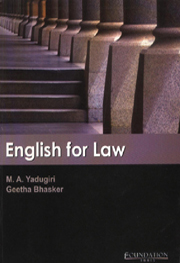Book contents
- Frontmatter
- Preface
- Contents
- A Note to the Student
- Notes to the Teacher
- 1 Nature of Law
- 2 Crimes and Civil Wrongs
- 3 Command of Language in the Profession of the Law
- 4 Plain Language and the Law
- 5 The Indian Constitution
- 6 The Impact of Technology on the Practice of Law
- 7 The International Court of Justice
- 8 Application of Precedents
- 9 Statutory Interpretation
- 10 Legal Reasoning
- 11 Plaints and Writs
- 12 Judgment
- 13 Of Defamation
- 14 Consumer Protection (Amendment) Act, 1993
- 15 The Information Technology Act, 2000
- 16 Universal Declaration of Human Rights
- Answer Key
4 - Plain Language and the Law
Published online by Cambridge University Press: 26 October 2011
- Frontmatter
- Preface
- Contents
- A Note to the Student
- Notes to the Teacher
- 1 Nature of Law
- 2 Crimes and Civil Wrongs
- 3 Command of Language in the Profession of the Law
- 4 Plain Language and the Law
- 5 The Indian Constitution
- 6 The Impact of Technology on the Practice of Law
- 7 The International Court of Justice
- 8 Application of Precedents
- 9 Statutory Interpretation
- 10 Legal Reasoning
- 11 Plaints and Writs
- 12 Judgment
- 13 Of Defamation
- 14 Consumer Protection (Amendment) Act, 1993
- 15 The Information Technology Act, 2000
- 16 Universal Declaration of Human Rights
- Answer Key
Summary
What is Plain English? (Martin Cutts)
What is really meant by plain English? Is it anything more than a slogan used by campaigners to publicise themselves and their favourite cause, and by businesses selling editing and document design services?
Undoubtedly plain English is a woolly term. As no formula can genuinely measure the plainness of a document, I would rather describe plain English than define it. In my view, plain English refers to:
The writing and setting out of essential information in a way that gives a cooperative, motivated person a good chance of understanding the document at first reading, and in the same sense that the writer meant it to be understood.
This means pitching the language at a level of sophistication that suits the readers and using appropriate structure and layout to help them navigate through the documents. It does not mean always using simple words at the expense of the most accurate words or writing whole documents in kindergarten language – even if, as some adult literacy surveys claim, some seven million adults in the UK and about 70 million adults in the US cannot read and write competently.
‘Plain’ has connotations of honesty, or should have. Essential information should not lie or tell half-truths, especially as its providers are often socially or financially dominant. For example, insurance policies should not hide management charges beneath a mass of detail and doublespeak.
- Type
- Chapter
- Information
- English for Law , pp. 93 - 132Publisher: Foundation BooksPrint publication year: 2005

